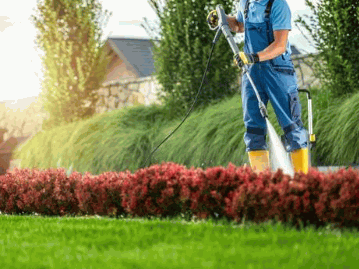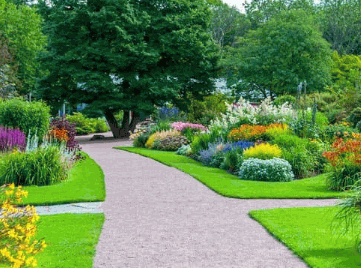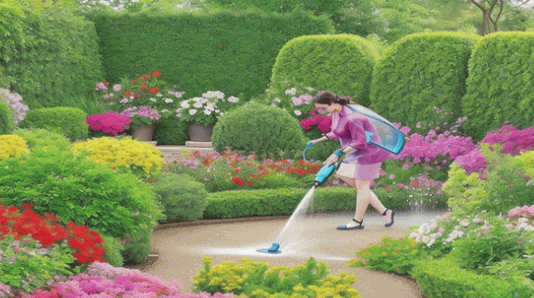Pressure washing your outdoor space needs protection for your plants. Despite the power of water, there are ways to protect them.
- Cover delicate plants with plastic or fabric sheeting. This will shield them from water and damage from high-pressure spraying.
- Keep the nozzle two feet away to minimize damage.
- Use a wider spray pattern to distribute pressure evenly and reduce intensity.
Why Is It Important To Protect Plants When Pressure Washing?
To save plants from damage when pressure washing, take precautionary steps! The high-pressure water could strip away foliage, disrupt growth patterns, or uproot plants from their foundation. Plus, some cleaning solutions are toxic to plants. To protect them, you can:
- Cover plants with waterproof tarps or plastic sheeting. Secure the coverings tightly to ensure full protection.
- Lower the pressure setting or use a wider spray pattern. This disperses the water more gently.
- Be mindful of the cleaning solutions used. Read and follow instructions carefully. Test a small area first, or find plant-friendly alternatives.
- Relocate potted plants away from work areas. Cover delicate flowers with buckets.
By following these protective measures, your plants stay healthy while enjoying a thorough cleaning session.

Preparing The Area For Pressure Washing
To pressure wash safely, some essential steps must be taken. To protect plants and prevent damage, follow these steps:
- Clear the area of any debris, like rocks, sticks, or toys, that may be caught by the water.
- Cover sensitive plants with plastic.
- Trim overhanging branches or foliage.
- Use eco-friendly cleaning solutions.
These steps will help preserve the health of your plants. Additionally, avoid direct pressure on fragile plants, like ferns or orchids. The Family Handyman website also suggests using a nozzle with a wider spray pattern to reduce the risk of damaging plants.
Adjusting The Pressure Washer Settings
Select the correct nozzle for the job. A wider one is gentler, while a narrower one gives more power. Set the pressure on your washer according to your plants’ sensitivity. Generally, a low pressure is best. Use a detergent designed for plant protection if you need to remove grime. Follow the instructions on how to use it safely. Keep a safe distance between the spray wand and your plants. Test the settings on a small area first. Different plants may have varying levels of tolerance to pressure and sprays. Research or ask an expert to determine what is best for your plants.
Check out: Does Pressure Washing Damage Patio

Cleaning Around The Plants
For safeguarding your plants while pressure washing, keep the following details in mind:
- Maintain a safe distance between the nozzle and the plants. This will prevent harm from detached debris.
- Use a fan spray nozzle to evenly disperse water and reduce the risk of concentrated pressure.
- Cover sensitive foliage with plastic covers or lightweight fabric.
- Choose eco-friendly cleaning solutions to avoid harming the plants.
- Thoroughly rinse the area around the plants to remove any detergent.
- Trim overhanging branches before starting.
- Limit the duration of pressure washing around your plants.
Rinse Thoroughly After Pressure Washing
Give your plants a thorough rinse post-pressure washing – it’s essential to shield them from any lingering residues or chemicals.
- Jump-start the process by using a hosepipe to sprinkle them with fresh H2O.
- Ensure that both the foliage and the earth encircling them are doused too.
- Maintain the rinse for at least a few minutes, making sure all grime and soap is gone.
To make sure they’re totally safe, it’s vital to remove any trace of cleaning solutions or detergent from the plants. Rinse them right up until no traces linger.
A pro tip: Before you pressure wash the plants, test a small section to check they can handle the water pressure.
Aftercare For The Plants
After pressure washing, it’s crucial to give proper aftercare to your plants. Here’s a step-by-step guide to keeping them healthy and happy:
- Clear the debris: Carefully remove any dirt or debris around your plants. This prevents smothering and lets them breathe.
- Check for damage: Look for broken branches, wilted leaves, or uprooted plants. If you spot any, take action right away.
- Give them a drink: Give your plants a good watering to replenish their moisture levels. This helps them recover from stress and stay hydrated.
- Add fertilizer: Boost your plant’s growth and recovery with organic fertilizer. It gives them essential nutrients and promotes healthy foliage.
- Keep up the care: Keep up regular plant care practices like watering, fertilizing, and protecting them from pests or diseases. Monitor their progress closely.
Remember, each plant species has different requirements, so adapt these steps accordingly for best results. Pro Tip: When pressure washing near fragile plants or young seedlings, use plastic sheets or tarpaulin to create a protective barrier from direct water spray.

Conclusion
Pressure washing can be a great way to clean outdoor surfaces. But, you must protect your plants. Here are a few steps to do so:
- Cover delicate or sensitive plants with a barrier, like plastic sheets or tarps. This shields the plants from the force of the water.
- Use a lower pressure setting when near plant areas. Higher-pressure settings can cause significant damage, such as stripping leaves or uprooting plants.
- Use a wider nozzle spray pattern when cleaning around delicate flowers. This will distribute the water over a larger area and reduce the intensity of the spray.
Pro Tip: Before starting, wet the plants with plain water. This provides an additional layer of protection.

